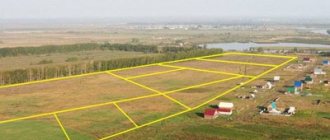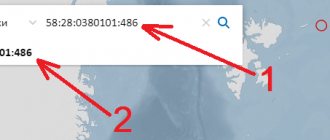Home / Real estate / Land / Categories of land plots
Back
Published: 11/02/2017
Reading time: 8 min
0
497
Land plots owned by citizens must be exploited in strict accordance with the category of land and the type of permitted use (AUR) of the site, otherwise penalties and seizure of land are possible. Changing the type of land use occurs by contacting the local administration.
- The concept and need to change the VRI of land plots
- How to change the type of permitted use?
- Required documents
- Procedure
- Possible costs
- Conclusion
The concept and need to change the VRI of land plots
The type of permitted land use is a list of activities that can be carried out on a site in accordance with its category of land. Each category of land corresponds to several types of permitted use, a complete list of which is given in Order of the Ministry of Economic Development No. 540.
Changing the VRI of a plot occurs without changing the category of land and is regulated by the following laws:
- Land Code of the Russian Federation;
- Town Planning Code of the Russian Federation.
Art. 39 of the Town Planning Code determines the rules for changing the VRI of a site located on the territory of populated areas, and the procedure for changing the type of land use of agricultural plots is determined by the laws of the constituent entities of the federation and municipalities.
Land users change the VRI in the following cases:
- Upon receipt of a building permit;
- If necessary, change the type of activity on the site;
- When renting out land.
On plots intended for gardening or field farming, permanent residential buildings cannot be built, and changing the VRI for such lands will help obtain permission for their development.
Owners of agricultural plots must also change the type of permitted land use depending on the planned activity or the needs of the tenant.
Purposes of its use
The purposes of using non-residential premises must correspond to the type of activity carried out in it, and can be as follows:
- Communal and household.
- Medical.
- Educational.
- Trading.
- Production.
- Warehouse.
- Office.
- Sports.
- Intended for public catering.
- Free appointment, etc.
EGRN includes a list of information presented in text and graphic form, and consists of: real estate cadastre, register of rights to real estate, register files, register of boundaries, cadastral maps and books of documents (Article 7 of the Federal Law No. 218 of July 13, 2015 .).It is worth noting that the Register stores not only current data, but also previously entered information about real estate objects.
According to functionality, there is a division into:
- Basic.
- Attendants.
- Technical.
- Communication.
- Auxiliary.
Thus, non-residential premises can be used for a variety of purposes, in addition to living in them.
How to change the type of permitted use?
The VRI of a land plot can be changed by a special commission formed under the local executive authority under whose jurisdiction the given plot is located. The commission considers the issue based on the application and makes a decision:
- Based on the results of public hearings;
- No hearings.
Public hearings are scheduled if there are interested parties in the form of neighboring land users, whose legitimate interests may be affected when changing the type of permitted land use of the applicant’s site.
Decision-making without public hearings is made only in the absence of private individuals among neighboring land users, when the VRI of a site on state lands changes.
The following categories of land users can submit an application to local authorities :
- Owners;
- Tenants;
- Holders of the right of perpetual use or inheritable ownership.
If an application to change the VRI is submitted by the tenant, he needs the consent of the owner in writing.
Statement
It is recommended that you submit your application in person to ensure that it has been registered and processed. But you can also send it by mail, by certified or registered mail, because it is not always possible to visit the local administration yourself. It is important that there is a document confirming the sending of this letter.
When presenting arguments in favor of changing the type of permitted use of your site or only part of it, you must write strictly in a business style, without using unnecessary phrases. Various legal terms on the topic will improve your writing experience.
If you have any doubts about your abilities, you can take advantage of the valuable help of a lawyer working in the field of land and civil law.
After a public hearing, the local administration may refuse the application. The reasons for refusal will be an incomplete set of documents, inaccurately specified data, and insufficient argumentation on the issue of change.
Also, the VIR does not change if there is a regional ban on such operations or the site belongs to unique land areas that can only be used strictly for certain purposes. If the documents were simply filled out incorrectly or not all of them were collected, you can resubmit the application after correcting the shortcomings.
IMPORTANT! If the application is submitted a second time, it shall indicate the reason for the previous refusal.
It should also indicate that all errors have been corrected.
Required documents
To change the VRI of a land plot, you will need the following documents:
- Application to the local executive authority;
- Cadastral document;
- Situational site plan;
- Extract about the owner of property rights;
- Owner's consent (for tenants);
- Copy of the passport.
If the land user submits an application through a representative, a notarized power of attorney will be required. An extract about the owner can be ordered from the Rosreestr department or the MFC. The situation plan is provided by the land committee of the local administration free of charge or prepared by surveying firms on a commercial basis.
Legal entities need to additionally prepare:
- Extract from the Unified State Register of Legal Entities;
- Registration document;
- TIN.
If the land is leased from a municipal owner, then a separate consent is not required; it will be obtained during the consideration of the application.
How is land transfer carried out?
How to change the purpose of land? Despite the fact that each plot has a specific classification, in some cases an interested person or its owner can initiate the procedure for changing the category of land. So, in order to carry out this procedure, you need to take the following steps:
- Submit an application to the land committee under the administration of the district in whose department the corresponding plot is located, with a requirement to carry out this action to change the intended purpose.
- To analyze the application, the department takes a regulatory period of 60–90 days, during which it analyzes the fundamental possibility of changing land categories, as well as the nuances and consequences arising from this action.
- If these lands are not subject to a federal ban or they are not burdened with any government programs or do not constitute strategic lands, then the department can give consent, and the procedure will be completed within 15 working days.
Important! In fact, as a rule, most sites are transferred for quite a long time, since district, regional or federal authorities always come with clarifications on the development plan of the territories, the presence of restrictions in these areas in the form of environmental zones and other encumbrances associated with the impossibility of exploiting the land in accordance with with the desired purpose. Therefore, the interested party should inquire about successful cases of completion of this operation before changing the use of land
To summarize, it should be said that the unauthorized use of land for purposes other than its intended purpose can have very dire consequences for its owner, especially if the non-targeted activities of an enterprise or individual affect the interests of third parties. Thus, for a violator, in accordance with judicial practice in the country, it is possible to apply penalties, dismantling constructed structures, the impossibility of registering them as real estate, as well as criminal proceedings if the activities of this person caused severe harm to others or their property.
Settlement lands
Procedure
In general, changing the permitted use of land is carried out in the following order:
- The land user collects the necessary documents and submits an application to the head of the executive branch;
- If the application is drawn up correctly, the town planning and land committees form a commission;
- The Commission sends notices of upcoming hearings to land users whose plots are located in the same zoning area as the applicant's plot;
- Public hearings are held;
- Based on the results of the hearings, the commission makes a decision;
- If the decision is positive, an act on changing the VRI of the declared site is drawn up;
- Based on the act, changes are made to the Unified State Register.
A sample application text can be downloaded from this link. The application must include the following information:
- Full name and contact information of the land user;
- Category of land and address landmarks of the site;
- Current and requested VRI;
- Reason for changing land use;
- List of attached documents.
The maximum period between the distribution of notices of hearings through the media or mail and the commission’s adoption of a decision is established by local legislation, but cannot exceed 30 days (Clause 7, Article 39 of the Urban Planning Code).
During public hearings, the applicant speaks, arguing for the need to change the VRI, and interested parties express their opinions on the consequences of changing land use to members of the commission.
Dissenting opinions and objections must be submitted to the commission members in writing.
When making a decision, the commission is guided by the following factors:
- The feasibility of changing the VRI;
- Consequences of changes in VRI for the environment;
- Legal and economic consequences for neighboring land users.
For example, if the owner of a gardening plot wants to change the VRI to build a house, the commission may reject the application due to the threat of shading of the neighboring cultivated plot.
If the commission decides to change the type of land use of the site, a copy of the decision is sent to all participants in the hearing. 10 days after the decision is made, an act on changing the VRI is drawn up, a copy of which is issued to the applicant. The applicant must contact Rosreestr to register changes in the cadastral register, attaching the following papers to a copy of the act:
- A copy of your passport;
- Receipt for payment of state duty;
- Application for amendments;
- Cadastral passport for the plot.
The new type of permitted land use will be displayed on the cadastral map of the area within 7-10 days from the date of application to Rosreestr.
If the applicant does not agree with the decision of the commission, he can challenge this decision in court (clause 12 of article 39 of the Civil Code of the Russian Federation).
Improper use - liability
Using non-residential premises for other purposes is fraught with administrative liability , and therefore, both legally and in fact, one must adhere to all legal requirements and norms.
In addition, Art. 15 of the Housing Code of the Russian Federation contains a number of requirements that a residential premises must meet, and, therefore, if they are violated, living in it is prohibited, it is automatically recognized as non-residential.
There is currently no direct liability for living in a building that does not meet the requirements of the law. But there are penalties regarding non-compliance with SES standards : noise level, layout, occupied space, lighting, etc.
In monetary terms, ordinary citizens face a fine of 500-1000 rubles, officials and individual entrepreneurs will have to pay 1000-2000 rubles, and legal entities - 10,000-20,000 rubles. Entrepreneurs also face suspension of activities for up to 90 days, and legal entities. persons for a period of up to three months (Article 6.4 of the Code of Administrative Offenses of the Russian Federation).
The essence of imposing fines is not punishment as such, but the protection of the life and health of the citizens themselves, because staying in a facility that does not meet the requirements is not at all safe .
Possible costs
Registration of a change in the type of land use of a site may include the following costs:
- State duty – 350 rubles;
- Ordering a cadastral extract from the MFC – 300 rubles;
- Preparation of a situation plan – 1500-3000 rubles;
- Organization of public hearings – 3000-10000 rubles.
All costs associated with the hearings must be covered by the land user who submitted the application to change the VRI (Clause 10, Article 39 of the Civil Code of the Russian Federation). It is necessary to pay for the distribution of notices, registration of participants in the hearing and rental of the venue. Depending on the number of participants and the region where the event is held, the cost may vary greatly.
Additional payment to pension for work in the Far North is the topic of our article. What can you expect if you live to 80? Read about government support for old people in our material.
You will learn the reasons why it is beneficial to quit by agreement of the parties in our article.










